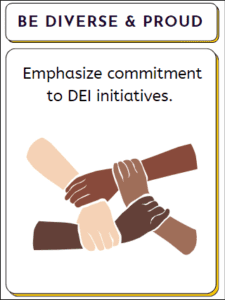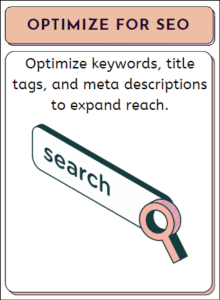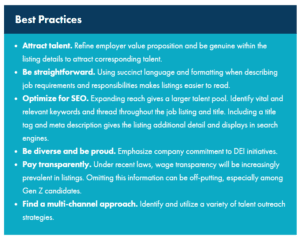With more jobs than candidates to fill, the right description is more important than ever.
By Alexis Whyte
In the current labor market, there are nearly two job openings per unemployed person, essentially giving job seekers the upper hand. And 77% of employers anticipate a shortage of qualified candidates in their online recruiting efforts. As it stands, candidates are inundated with a vast amount of job listings and opportunities to parse through while employers struggle to find the right fit. Since candidates have a number of prospects, how can organizations craft an innovative job listing to attract the ideal contender?
The Evolution of Talent Acquisition to Talent Attraction
To compete in today’s job landscape, the content within job descriptions must attract the right talent, whether passive or active. As Mark Burris, vice president of talent acquisition and HR program design at Korn Ferry, says, “Companies need to be moving toward a talent attraction approach to recruiting rather than the days of talent acquisition.” So, in an ever-evolving market, what attracts talent?
Increasingly, candidates seek companies that mirror their personal values, particularly those from underrepresented groups. This means, employers must genuinely convey their values in a job listing while prioritizing responsibilities and requirements. Otherwise, if candidate perceptions misalign with company values, it can drive away suitable talent.
Burris recognizes that candidates are taking additional steps to vet employers during the search and application process. “Candidates are much wiser these days and will take the time to study potential employers ahead of responding to recruiters or applying to roles they may be qualified for,” he says.
Companies must also openly convey their employer value proposition within a job listing and throughout their website, as 64% of candidates use a company’s website directly to search for jobs. Unclear, long-winded, or jargon-filled job listings will not attract the talent needed in today’s climate.
Lance Sapera, VP of talent acquisition at Talend, recognizes the shift to talent attraction and is taking the necessary measures to get the right candidates in.
“We are currently working on video clips from our hiring managers and team members that more effectively convey both the opportunity at Talend and what a day in the life looks like. We also want to do a better job of sharing our culture as a competitive advantage,” he says, giving the recent Comparably Best Company Leadership Award as an example.
 Eliminating Bias and Promoting Inclusivity
Eliminating Bias and Promoting Inclusivity
According to Workday’s 2022 Employee Expectations study, 76% of employees consider belonging and diversity initiatives important when evaluating companies or job offers. Often, a myriad of tools are necessary to successfully reduce bias and highlight inclusivity in job listings. Sapera says Talend uses web capabilities, such as the inclusive language feature in Microsoft Office 365 applications, to measure inclusivity within listings as a single tool, but the work doesn’t stop there.
“We proactively offer unconscious bias and inclusive interview training for all our recruiters,” he says. “We are also building inclusive interviewing into our formal hiring manger and interview training.”
This multi-faceted approach ensures the importance of diversity is prevalent throughout the language and content of a job listing and is reinforced throughout the hiring process.
Posting Pay for Transparency
A recent Lattice study found that 67% of employees in the U.S. want more pay transparency in their companies and throughout the hiring process. Crucial to eliminating pay gaps and inequalities, transparency in a job listing shows candidates what to expect from an organization. Including a salary range in a job description limits discrepancies and unconscious bias in offers while giving job seekers clarity before applying. Overall, this approach saves employers and candidates time if a role’s salary cannot meet existing expectations.
Employing a Multi-Channel Approach 
Recent research shows that 86% of job seekers use social media in recruiting. As the labor market grapples with talent shortages, expanding a listing’s reach is now more important than ever. To do this, TA leaders should use a mix of channels to promote listings and open roles. While there is no one-size-fits-all approach or strategy, organizations need variations for more eyes on their carefully curated listing. Burris says, “The best companies at [recruitment] are diversifying their talent outreach strategies to include specialized job boards, networking events, and utilizing referrals and academic programs.” This medley encourages a particularly diverse talent pool.
Sapera focuses on Talend’s network and internal team members first in their multi-channel approach. “Gaining visibility to new candidates is certainly important to us; however, we focus on ‘people we know and who know us.’ We want our team members to grow their careers here,” he says.
Talent attraction strategies will continue to change as the market does so organizations are best suited to leverage a variety of approaches.















